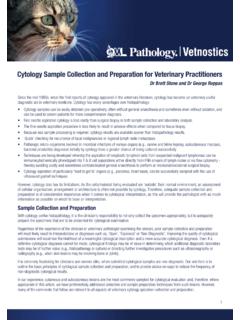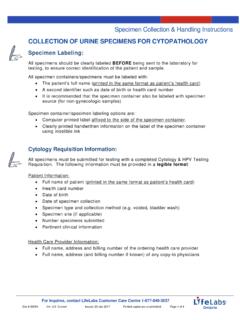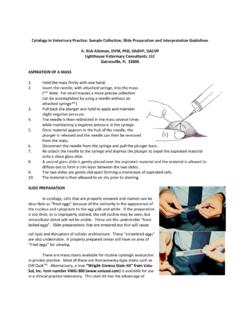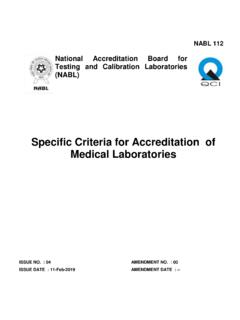Transcription of CYTOLOGY REFERENCE GUIDE Dechra Veterinary Products
1 CYTOLOGY REFERENCE GUIDED echra Veterinary ProductsCytology is a quick, simple-to-perform method to achieve useful information about the possible etiology of cutaneous lesions. This REFERENCE GUIDE was created as a source of step-by-step recommendations to assist the Veterinary team in proper collection and preparation of appropriate cytological samples . Dechra s goal is to allow you to confidently diagnose and prescribe utilizing thanks go out to the many veterinarians who helped write and contribute STAIN MAINTENANCE:1. Microorganisms can grow in stain solutions which can lead to artifact of bacterial overgrowth on slides. Recommended to maintain two separate staining set-ups: clean CYTOLOGY for blood smears and effusion CYTOLOGY and dirty CYTOLOGY for otic, cutaneous impression and fecal smears. In a busy practice, stains may require changing If samples are staining poorly, the stains should be replaced.
2 Stain jars should be thoroughly cleaned and dried before filling with fresh stain Keep the lids closed on stain jars, especially the light blue fixative (first solution), as it evaporates quickly. NOTE: Keep all unstained slides away from formalin as exposure will interfere with :1. Apply one to two drops of mineral oil onto the microscope slide. Smear scalpel blade in mineral oil and also apply small amount of mineral oil to area to be Hold blade at a 45 degree angle to the skin surface and with moderate pressure, repeatedly scrape the lesion in the direction of hair growth and away from your hand. It may be necessary to clip the hair over the area to facilitate adequate sample collection . a. Be careful not to press down on the blade, which could cut the Spread the collected sample uniformly in the mineral oil on the glass slide.
3 Place a coverslip. Scan the slide with 4X and 10X objective lens. To improve identification of mites, increase the contrast (4a).4. Methodically scan the entire sample by repeatedly moving from one side of the slide to the other side. a. To enhance visualization of mites using the 4X and 10X objective lens, partially close the microscope s iris diaphragm and lower the condenser to provide increased SCRAPING(For ectoparasite identification)3 MATERIALS NEEDED: Mineral oil Dull #10 scalpel blade Microscope slides Cover slips Microscope(Skin Scraping continued on next page)5. Two methods of skin scrapings are employed dependent on the mite suspected. a. Superficial skin scrapings are performed when looking for mites that live on or just below the skin surface , Cheyletiella spp, Demodex gatoi, Demodex cornei, Sarcoptes spp, Notoedres and trombiculoides mites.
4 Using a mineral oil coated scalpel blade, superficially scrape a wide area of skin collecting a large amount of scale and crust. No need to cause bleeding when looking for surface-dwelling mites. Transfer sample to mineral oil on microscope slide. Place a coverslip over sample. Recommend scraping more than one location. b. Deep skin scrapings are performed when looking for Demodex canis and Demodex cati they reside in hair follicles and sebaceous glands. Smaller areas are scraped but scrapes are deeper and repeated until slight bleeding (capillary ooze) is noted. NOTE: Always use a new scalpel blade between patients to prevent transfer of infectious organisms such as methicillin-resistant Staphylococcal Tips to Increase Recovery of follicular Demodex canis and Demodex cati Mites a.
5 Look for newly formed lesions. Gently squeeze or pinch skin to express mites closer to the skin surface from deep within the hair follicle. Repeatedly scrape area until superficial bleeding is noted. Transfer sample to microscope slide. b. Recommend scraping more than one lesion. c. If lesions are in body locations that are difficult to scrape (around the eye or interdigitally), plucking hairs from the lesion with forceps can be performed. Place hairs in mineral oil on glass slide, apply coverslip and scan slide with 4X Tips to identify Sarcoptes Mites: a. Scabies mites live in the stratum corneum (superficially) and are often few in number; sampling multiple lesions and larger areas can be helpful. b. Obtain multiple, wide, superficial scrapings of crusted, or alopecic lesions on elbows, pinnal margins, and the ventral SCRAPING4(Skin Scraping continued on next page)8.
6 Tips to identify Cheyletiella Mites ( walking dandruff): a. Cheyletiella are relatively large surface-dwelling mites that are often found along the dorsum and are quite visible on 40X magnification. b. Obtain wide, superficial scrapings of scaly lesions, and place these scrapings in mineral oil for microscopic examination. c. Cheyletiella Mites can also be found using multiple applications of clear (not frosted) acetate tape onto scaly areas, or collected through the use of a flea SCRAPINGA dult canine sarcoptic (scabies) mite -- Sarcoptes scabieiCanine Sarcoptes scabiei eggs(Sarcoptes scabiei var. canis) Courtesy of University of Illinois Courtesy of University of Illinois(Skin Scraping continued on next page)5 SKIN SCRAPINGA dult feline sarcoptic mites Notoedres cati Courtesy of Kimberly Coyner, DVM, DACVDC heyletiella Mites Courtesy of University of IllinoisAdult and nymph Demodex MitesDemodex egg Courtesy of University of Illinois Courtesy of Kimberly Coyner, DVM, DACVD6 STEPS:1.
7 Press sticky side of tape to hair and skin repeatedly covering a wide area. Take several samples from different affected Apply sticky side of tape to microscope slide. Examine entire slide with 40X and 100X magnification (4X and 10X lens).ACETATE TAPE IMPRESSIONS(For identification of surface mites , cheyletiellosis and lice and microbes)MATERIALS NEEDED: Clear (not-frosted) acetate tape or packing tape Microscope slides MicroscopeAcetate tape impression Courtesy of University of Illinois7 STEPS:1. Grasp a small number of hairs and epilate in the same direction as hair growth to prevent Lay hairs in mineral oil on glass slide in same orientation as plucked. Place Examine entire length of hair from root to tip. Lower condenser +/- partially close iris diaphragm to improve contrast while scanning the sample.
8 A. Hairs have either anagen (growing phase of hair cycle) or telogen (resting phase of hair cycle) bulbs healthy adult animals have a mixture of both i. Anagen bulbs rounded, smooth, glistening, often pigmented and soft, the root may be curved ii. Telogen bulbs club- or speared-shaped, rough-surfaced, non-pigmented, and generally straightTRICHOGRAM (Hair Examination)(Useful sampling technique for examination of morphology of hair shaft, identification of dermatophyte infection and ectoparasite infestation, and determination of phases of hair growth cycle.)8 MATERIALS NEEDED: Mineral oil Curved small hemostats (Note: recommend not collecting samples with fingertips due to possible zoonotic potential of some diseases) Microscope slides +/- Coverslip Microscope(Trichogram continued on next page)3.
9 B. A normal hair is uniform in diameter and tapers gently towards the distal tip. c. Melanin granules (hair pigmentation) should be relatively uniform in size and evenly (Trichogram continued on next page)Trichogram Prep Courtesy of University of IllinoisAnagen BulbTelogen Bulb Courtesy of Kimberly Coyner, DVM, DACVD Courtesy of Kimberly Coyner, DVM, DACVDTRICHOGRAMR efractile macroconidia and hyphae in dermatophyte-infected hairFrayed distal tip of hair secondary to excessive grooming (self-inflicted alopecia)10 Courtesy of University of Illinois Courtesy of Kimberly Coyner, DVM, DACVDTRICHOGRAM1. Hair plucks can be collected from areas difficult to scrape, such as paws when investigating for demodicosis. Demodex Mites can be found clinging to the hairs, especially the lower portion of the hair shaft.
10 May see parasitic eggs (lice, Cheyletiella spp) attached to If suspect dermatophytosis, look for abnormal or thickened hairs with irregular borders. Use 40X objective lens to look for refractile arthroconidia and hyphae. Microscopic identification of dermatophytes is quite difficult and can be easily Large and/or irregular clumps of melanin within the hair shaft are suggestive of color dilution Keratin casting around a hair is common in sebaceous : Neutrophilic or pyogranulomatous inflammation suggests an infectious or inflammatory process. Eosinophilic infiltrate suggests a hypersensitivity or parasitic dermatitis, but can also be seen in other dermatoses, such as some drug reactions. Acantholytic (single keratinocytes that have lost their attachment to neighboring keratinocytes and become rounded) cells are found most commonly with pemphigus complex but can also be seen with chronic bacterial or dermatophyte infections.












